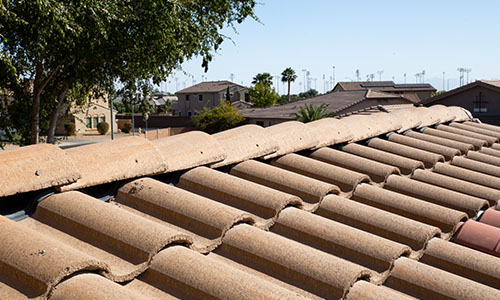One of the first tasks of a new roofer will be to set foot on a roof, but just because it’s the first step to roofing doesn’t mean it’s easy, or safe. Every year an average of 37 roofers fall to their deaths. Primarily from falling of the roof edge. This is despite roofers having specialized training and equipment. Naturally, a homeowner should be exceptionally careful when setting foot on their roof.
In this article we’ll cover walking on a tile roof, the preparation needed, and the potential risks to you and your home. Keep in mind that there’s no 100% safe way to walk on a roof. Some risk will always be involved, but we’ll teach you how to minimize that risk as much as possible.
What are the risks of walking on a tile roof?
Tile Breaking
Walking on a tile roof can lead to breakage. The brittle nature of tiles, often exacerbated by weathering, makes them susceptible to cracking under human weight and pressure. Even with cautious steps, accidental missteps or uneven weight distribution can cause tiles to shatter. Factors like age, material quality, and maintenance also contribute to fragility. Old tiles roofs will inevitably have some breakage, while newer tiles roofs are less weathered, making them much more resilient.
Slipping due to loose tiles

Slipping on a roof poses a significant risk, especially for the inexperienced or in the presence of loose tiles. The absence of proper footing and the uneven surface can lead to dangerous falls. Loose tiles, vulnerable due to wear or poor installation, further exacerbate this hazard. When stepped on, they can easily dislodge, leading to a precarious tumble. Inexperienced individuals are not recommended to go on old or poorly installed roofs under any circumstances.
Slipping due to rain
Venturing onto a roof should only occur in dry conditions; otherwise, the risk of slipping escalates significantly. Wet or damp surfaces drastically reduce traction, making even a cautious step perilous. Moisture weakens grip and stability, leading to slips, falls, and potential injuries. Wet tiles or shingles become slippery, amplifying the danger. Waiting for dry weather is crucial, ensuring a secure footing and minimizing the risk of accidents. Safety precautions, like choosing the right weather conditions, are paramount when accessing the time for walking on a tile roof.
Electric Shocks
Walking on a roof carries the peril of overhead powerlines and lightning strikes, both capable of causing fatal electric shocks. Accidental contact with powerlines can result in severe electrocution. Thunderstorms can also be a particular risk when working on a roof. These can be avoided simply by avoiding walking on roofs with powerlines over them, and making sure that you don’t go out during a thunderstorm.
Preparation
Footwear
Selecting appropriate footwear for walking on a tile roof is vital for safety and stability. Opt for shoes with non-slip rubber soles, offering excellent traction on various surfaces. High-top shoes or boots provide ankle support, reducing the risk of twists or sprains. Look for lightweight yet durable materials to maintain agility. Avoid heavy boots can lack the necessary finesse for navigating a roof. Avoid shoes with worn-out soles, as they compromise grip. Ensure your footwear is in good condition before ascending a roof.

Clothing & Pants
When walking on a tile roof, choosing the right pants is essential for comfort and safety. Go for durable materials like heavy-duty cotton, denim, or canvas that protect against abrasions. Consider pants with a grippy texture, aiding in sitting securely without slipping, especially on steep roofs. Look for reinforced knees for extra protection. Prioritize a snug fit to prevent snagging and ensure ease of movement.
Hands-Free Storage
Utilizing hands-free storage is a smart choice when walking on a tile roof, as it maintains your agility and safety. By keeping your hands unburdened, you’re better equipped to maintain balance and make necessary adjustments while on a roof. Options like tool belts, harnesses, or pouches ensure essential items are within reach, enhancing efficiency and minimizing the risk of tripping or accidents. Hands-free storage will also be necessary if you want to crawl along a roof, which might be the best option for particularly dangerous circumstances.
Walking on The Roof
When walking on a tile roof, strategic placement of your steps is key to minimizing the chance of breaking and slipping. Walk with your foot perpendicular to the tiles so that your foot can rest across two or more tiles. Distribute your weight evenly over multiple tiles by walking flat-footed, putting some weight on your toes and some on your heels. Aim to walk on the lower third of the tiles, near the lower edge where they overlap, as this area is less prone to breaking due to the way weight is transferred. Take small, deliberate steps to maintain balance and reduce the impact on individual tiles.

When walking on a roof, keep a look out for potential dangers. First and foremost, be aware of your surroundings. Look out for overhead power lines, ensuring you maintain a safe distance to avoid electrical hazards. Additionally, avoid walking on tiles that appear loose, cracked, damaged, or that are sticking up. Instead, opt for tiles that are secure and stable. Watch for debris, especially in the gutters, which can cause slips or imbalance. If the roof is sagging under your weight or else in poor condition, proceed with extreme caution or get off the roof entirely.
Look Out For:
- Overhead Power Lines
- Damaged Tiles
- Tiles that Stick up
- Debris
- A Sagging Roof
Across ridge of a roof is often the safest spot to walk. Its peak provides a stable surface with a broader area for footing, reducing the risk of tile breakage. When navigating a roof, consider walking with either foot on each side of the ridge whenever possible. It offers better balance and support, ensuring a secure and confident stride.

Crawling on a roof
Crawling over a roof can be a wise and safe approach, especially on steep or delicate surfaces. When adopting this method, you distribute your weight evenly, minimizing the pressure on individual tiles and reducing the risk of breakage. It also offers a lower center of gravity, enhancing balance and stability.
To crawl safely, move deliberately and maintain three points of contact, such as two hands and a foot or knee, at all times. This technique ensures you remain steady and in control, even on otherwise dangerous roofs. Check for sharp objects or nails that may cause problems for your hands and feet. Additionally, wearing knee pads can protect against abrasions and enhance comfort during crawling.
In Conclusion
Navigating a roof demands careful attention, regardless of your level of experience. By being mindful of your steps, considering the condition of the roof, and utilizing safety equipment, you can significantly reduce the risks associated with working at heights. Just remember that working on roofs is inherently dangerous and that getting hurt is a real possibility.
Remember, knowledge and preparation are your best tools. Stay informed about the specific risks associated with your roof, and always prioritize safety protocols. If you’re uncertain or uncomfortable with the task, consider hiring us to handle the job for you. We have an experienced team that would be glad to work on your roof.

